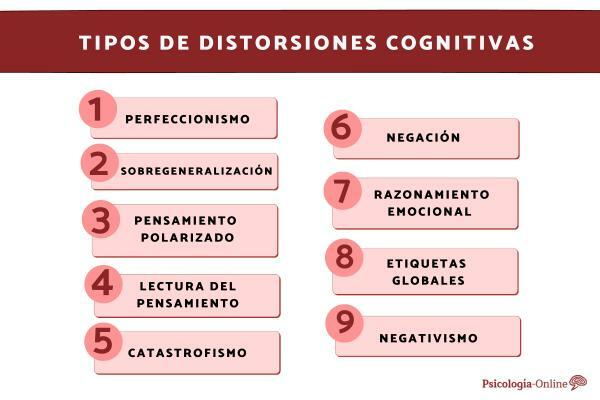
Our way of thinking and interpreting the world influences our emotions and, therefore, the way we feel. This is why it is vitally important to pay attention to our mental schemes and try to make them as positive and healthy as possible. However, not all the interpretations we make of reality are correct and sometimes we can have cognitive distortions.
In this Psychology-Online article: cognitive distortions: what they are, types and examples, we are going to explain in more detail what this topic consists of, as well as let you know the way in which you can change this type of irrational thoughts or cognitive distortions for more positive ones and rational.
Index
- What are the cognitive distortions
- perfectionism
- overgeneralization
- polarized thinking
- mind reading
- catastrophism
- The negation
- emotional reasoning
- global tags
- negativism
- How to work cognitive distortions
What are the cognitive distortions.
Cognitive distortions are all those wrong interpretations of reality
Most people usually present some cognitive distortion and it is important to know how to detect them in time to prevent them from wreaking havoc on our daily lives and health, both mental and physical. Below we will mention the main types of cognitive distortions, accompanied by examples:
perfectionism.
This type of cognitive distortion or irrational thinking causes us to have a rigid and inflexible idea about ourselves and how we should be in order to act in the “correct” way and always do things well.
A clear example of perfectionism is when we believe that we cannot make any mistakes because otherwise we will not be worth as much as people. When we pretend to be the children, friends or the perfect couple, when we demand too much ourselves, to the point of treating ourselves badly if we fail to achieve what we want or what we think we should have in order to be successful.

The overgeneralization.
This type of cognitive distortion refers to the tendency of some people to believe that something that has happened to them on some occasion will continue to happen to them many more times.
An example of overgeneralization would be the case of people who had an accident in the past and do not want to get into a car again for fear that it might happen to them again. Another example of this type of cognitive distortion is that of people who have suffered infidelity in a relationship and believe that the other partners they have will also do the same to them.
polarized thinking.
This irrational thinking or cognitive distortion refers to those people who they perceive everything in an extremist way. Some examples of this would be thinking that something, person or situation is wonderful or thinking that it is the opposite, that is, horrible.
Feeling extremely happy or extremely sad, being a totally good or extremely bad person are also polarized thoughts. That is to say, in this type of thinking there is no middle term, for the people who adopt it the world is black or white, there are no middle terms.
Mind reading.
This type of cognitive distortion has to do with believe that we can know what others think. An example of mind reading could be when we speak in front of several people and begin to think things like: "I'm sure they're making fun of me", "what I'm saying bores them already", "they think I'm a fool", etc. Another example would be to believe that one or several people envy us or that another person dislikes us when we have not even treated them, etc.
catastrophism.
This type of cognitive distortion refers to the tendency some people have to expect the worst of any situation without having any real and objective reason for it. An example of this type of distortion is thinking that the future will always be hopeless.
The catastrophic thinking it is, for example, being afraid to go on a trip because you have the belief that something is going to happen accident on the road or thinking that a small stomach ache could be a serious illness.

The negation.
This distortion refers to the fact that deny problems, mistakes and difficulties. An example of this type of irrational thinking would be the fact that a person does not admit that a situation adverse and difficult is causing him pain, as well as denying that he cares about any situation and subtracting importance.
emotional reasoning
Emotional reasoning refers to to think that things are as I feel or how they make me feel. For example, when I feel that I am a worthless person, I will have the belief that I really am, if I feel that I am a fool, it is that I really am, if another person makes me feel bad it is because it is bad.
Global labels.
This type of cognitive distortion refers to the fact of taking into account only one or two personality traits of someone and label it globally with that single trait. This can also be used for oneself. An example of this type of cognitive distortion would be not being good at languages and for this sole fact considering oneself an unintelligent person.
The negativism.
This type of cognitive distortion refers to the fact that give too much importance to negative things and devalue the positive ones. Some examples of this would be thinking things like: “it will surely be a bad day”, “I will never be able to get what I want”, “that person will not like me”, etc.

How to work cognitive distortions.
Cognitive distortions are learned, therefore, they can be changed. Cognitive restructuring techniques are often used cognitive behavioral therapy in which the psychologist helps to refute and reconstruct cognitive schemes.
Next, we will show you an exercise that will undoubtedly help you detect and eradicate the cognitive distortions that you experience and that, finally, you can learn to better manage your emotions.
1. identify an emotion
Identify the emotion you are experiencing right now, be it sadness, anger, rage, etc. Find out what are the physical sensations that accompany that emotion, whether it is a headache, stomach pain, dizziness or any other uncomfortable sensation that may appear. Understand the relationship between emotion (mind) and physical sensations (body).
2. identify your thoughts
Be aware of the type of thoughts you are having at that moment and identify them. For example, it may be that at that moment you are thinking things like: “how bad I feel”, “how unfair life is”, “everything goes wrong”, “I am afraid to do that”, etc.
3. Identify if it is a cognitive distortion
Finally, analyze what you are thinking and feeling and reflect on whether you are having any cognitive distortion. In the event that the answer is affirmative, identify which of them it is and analyze it objectively in order to change it.
For example, if you identify that you have used catastrophism and you are afraid, for example, of going on a trip in case you have an accident, start thinking that there are few possibilities that this happens, that you can always take the necessary measures to avoid it and that you are not going to stop doing the things you like and live new experiences for that traveling.

This article is merely informative, in Psychology-Online we do not have the power to make a diagnosis or recommend a treatment. We invite you to go to a psychologist to treat your particular case.
If you want to read more articles similar to Cognitive distortions: what they are, types and examples, we recommend that you enter our category of cognitive psychology.
Bibliography
- Labrador, f. J., & Manoso, V. (2005). Change in cognitive distortions of pathological gamblers after treatment: comparison with a control group. International Journal of Clinical and Health Psychology, 5(1).
- Rizo, W. (2009). cognitive therapy. Barcelona, Spain, Editorial Paidós Ibérica.


